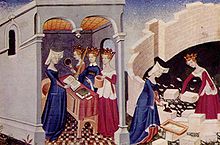
Back كتاب مدينة السيدات Arabic Llibre de la ciutat de les dames Catalan Le Livre de la Cité des Dames German La ciudad de las damas Spanish La Cité des dames French A cidade das mulleres Galician ספר עיר הגבירות HE Le Livre de la Cité des Dames ID La città delle dame Italian 숙녀들의 도시 Korean
 Illustration from The Book of the City of Ladies | |
| Author | Christine de Pizan |
|---|---|
| Language | French |
Publication date | circa 1405 |
The Book of the City of Ladies, or Le Livre de la Cité des Dames, is a book written by Christine de Pizan believed to have been finished by 1405. Perhaps Pizan's most famous literary work, it is her second work of lengthy prose. Pizan uses the vernacular French language to compose the book, but she often uses Latin-style syntax and conventions within her French prose.[1] The book serves as her formal response to Jean de Meun's popular Roman de la Rose.[2] Pizan combats Meun's statements about women by creating an allegorical city of ladies. She defends women by collecting a wide array of famous women throughout history. These women are "housed" in the City of Ladies, which is actually the book. As Pizan builds her city, she uses each famous woman as a building block for not only the walls and houses of the city, but also as building blocks for her thesis. Each woman introduced to the city adds to Pizan's argument towards women as valued participants in society. She also advocates in favour of education for women.[3]
Christine de Pizan also finished by 1405 The Treasure of the City of Ladies (Le tresor de la cité des dames de degré en degré, also known The Book of the Three Virtues), a manual of education, dedicated to Princess Margaret of Burgundy. This aims to educate women of all estates, the latter telling women who have husbands: "If she wants to act prudently and have the praise of both the world and her husband, she will be cheerful to him all the time".[4] Her Book and Treasure are her two best-known works, along with the poem Ditie de Jehanne D'Arc.[5]
- ^ Forhan, Kate Langdon. The Political Theory of Christine Pizan. Burlington: Ashgate: 2002. Print. Women and Gender in the Early Mod. World.
- ^ Green, Karen (2022). "The Miroir des dames, the Chapelet des vertus, and Christine de Pizan's Sources". The Intellectual Dynamism of the High Middle Ages. Amsterdam University Press. pp. 279–296. doi:10.1017/9789048537174.014. ISBN 9789048537174.
- ^ Allen, Prudence (2006). The Concept of Woman. Volume 2: The Early Humanist Reformation, 1250-1500. pp. 610–658.
- ^ Cantor, Norman. The Medieval Reader. p. 230
- ^ Willard, Charity C. (1984). Christine de Pizan: Her Life and Works. New York: Persea Books. p. 135. ISBN 9780892550845.
© MMXXIII Rich X Search. We shall prevail. All rights reserved. Rich X Search